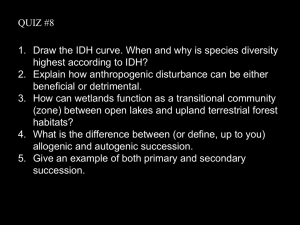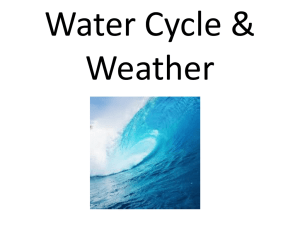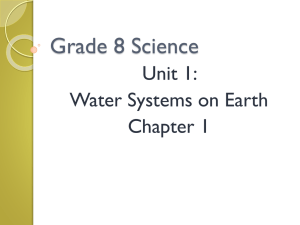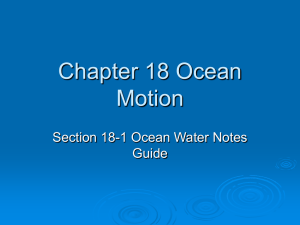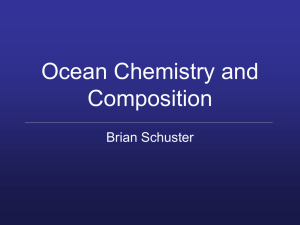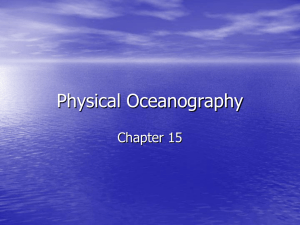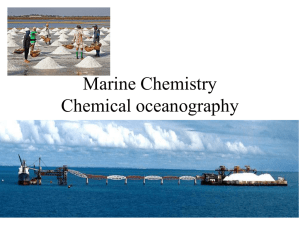Water: The Universal Solvent! Powerpoint
advertisement
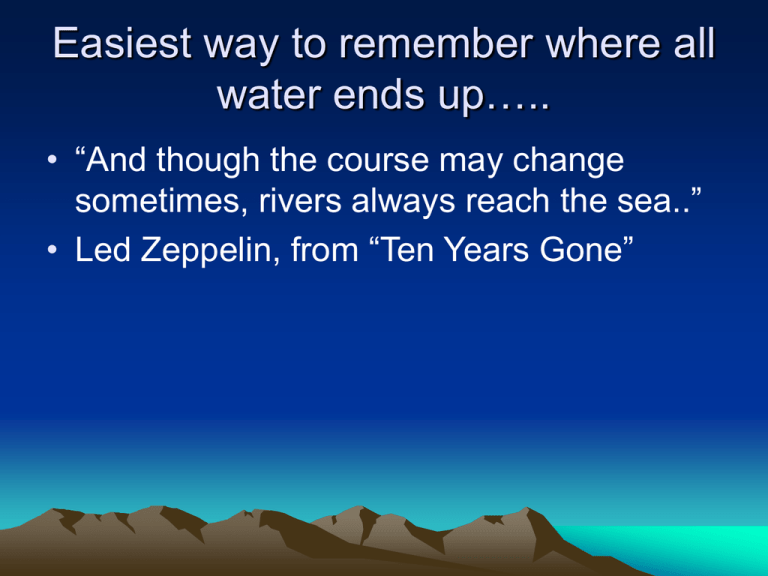
Easiest way to remember where all water ends up….. • “And though the course may change sometimes, rivers always reach the sea..” • Led Zeppelin, from “Ten Years Gone” Water, the universal Solvent! Why? Water as a solvent • If you fill a glass with tap water and leave it, notice that after the water has evaporated a stain is left on the glass • If a glass of ocean water is left sitting, the water will evaporate and what will be left? Salt! • These leftovers, called residue, were chemical substances that were dissolved in the water Water as a solvent • Any liquid, including water, that contains dissolved substances is called a solvent • Water is a good solvent because it can dissolve so many substances, and ocean water contains numerous dissolved substances, salt being only one of them • The study of chemical substances found in ocean water is called chemical oceanography Ocean Water • Made up of 96.5% water molecules • The remaining 3.5% is mostly salt, which is dissolved in the water • Any substance that is dissolved in a liquid (like water) is called a solute • In ocean water, salt is a solute because it’s dissolved in water, the solvent • This mixture between dissolved salt and water is called a solution Salt (solute)+Water(solvent)=salt water(solution) Ok, time to make YOUR solutions! • • • • • Groups of 4 please Grab a beaker Fill the beaker about 1/4 with tap water Pass around the salt Try to stir in at least 2 to 3 tablespoons of salt • Then, we wait! Substances in Sea Water • Many solutions, like ocean water are called mixtures • A mixture contains 2 or more substances that can be separated by ordinary physical means • For example, if salt water is left to sit – the water will evaporate and the salt will be left! Substances in Sea Water • The salts dissolved in ocean water are called sea salts, and sea salt is a compound • A compound is a substance that contains 2 or more kinds of atoms that are chemically bonded • Salt=sodium+chlorine (Na+Cl) • When salt is added to water, the compound breaks apart, creating charged particles called ions • Na is + charged, while the chlorine becomes a negatively charged chloride ion • Opposites attract! Substances in Sea Water • Another compound found in ocean water is calcium carbonate • This is also called limestone • Calcium carbonate is the main component of seashells and of coral reefs • Again, the wearing down of seashells and coral reefs releases calcium carb into the water, resulting in ions • Calcium is + while carbonate is – • How are ions joined? Electrostatic force! Sea Salts found in Sea Water • • • • • • • Sodium Chloride – 67% Magnesium Chloride – 14.6% Sodium Sulfate – 11.6% Calcium Chloride – 3.5% Potassium Chloride – 2.2% Other salts – 1.1% Remember, when sea water evaporates, all of these salts are left behind as residue! pH • pH is the degree of acidity or alkalinity of a solution • Water molecules break up into charged particles called ions • Water=H+ + OH• In this case, the hydrogen ion is positive, and the negative ion is called the hydroxyl ion • Since opposite charges attract, these ions bond to form water! Moving right along… • When a solution is an acid, it means that it contains a larger amount of hydrogen atoms than hydroxyl atoms • A solution that has a larger number of hydroxyl atoms than hydrogen atoms is called a base, or an alkaline solution • So technically, pH refers to the concentration of hydrogen atoms in a solution • The pH scale! 0-14 Acid Rain • Acid rain is formed when chemicals released by the burning of fossil fuels are absorbed by moisture in the air • Many bodies of water can become acidic due to this acid rain, such as rivers and streams – and many have • In extreme cases, these freshwater surface waters can have a pH of 4-5, and can result in massive fish kills • The oceans, however, have a much more stable pH and are less affected by acid rain • Why? • The oceans have much more surface area to dilute the acid rain! Buffers • Furthermore, the oceans have chemicals called buffers that can help maintain a stable pH • Buffers are substances that lessen the acidity or alkalinity of a solution • One of the main buffers in ocean water is the carbonate buffer • Limestone is made from carbonate, and limestone will accept hydrogen ions – so the water will become less acidic and more basic • It can also release hydrogen ions, causing the water to be MORE acidic and less basic • Since it can do both, pH is pretty much kept in check and a balance is maintained Oxygen in the Water • There is oxygen present in ocean water, as well as freshwater surface sources • This is called dissolved oxygen, or DO • Surprisingly, most of Earth’s oxygen supply comes from photosynthesis carried out by algae and plants that live in the photic zones of the water • After oxygen leaves the plants, some dissolves in the water and some is released into the atmosphere Soooo….. • Every time we breathe, we are inhaling some of the oxygen that marine plants and algae release! Oxygen Distribution in Water • Oxygen is not very soluble in water, so the actual quantity is small • Air can hold about 200ppm of oxygen, while water can only hold about 1-12ppm • There is definitely more DO present at the ocean’s surface than in the depths. Why? • Because the photic zone (the zone where light can penetrate) is at the surface, so that’s where photosynthesis by marine plants and algae takes place! Salinity • Obviously, ocean water has salt in it! • Does salinity vary in different ocean waters on Earth? • It varies only slightly • In ppt, salinity levels in the Pacific are about 35ppt, while the Atlantic levels are about 37ppt • However, areas like the Red Sea and the Mediterranean are even higher. Why? • They are in areas with hot climate, so there’s more evaporation and less precipitation • So, salinity varies with climate Salinity • Salinity also varies with latitude • Salinity is higher at 20 degrees N and S latitude than at the equator. Why? • Regions at the equator have a lot more rain! • A lot of rain will dilute the ocean water, rendering it less salty • Also, on coasts where freshwater rivers or streams enter the oceans salinity is also less Salinity and Depth • Salinity also varies with depth • Salinity in the deeper areas is higher than near the surface • At a depth between 100-200m is a layer of water called the halocline • This layer shows a rapid increase in salinity, and it continues to increase as depth increases • This is because colder water causes salt ions to move closer together, so it can hold more salt Sources of Salt • Freshwater rivers and streams that flow into the ocean • This is because these waters erode streambeds and riverbeds that contain natural salts, and also salts from adjacent land areas enter the streams and rivers in the form of surface runoff • Salt also comes from the ocean floor from hydrothermal vents that emit hot, mineralized water into the oceans • The minerals present in the water include sodium and chloride!
